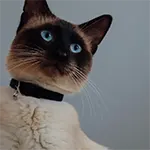
Balinese cat draws a lot of attention, especially those who like the Siamese and Burmese cats. Like the Siamese, it has a striking color point pattern, but its coat is medium in size.
Summary
Origin
Despite its name, the Balinese cat does not come from Bali or Indonesia. This breed is the product of focused breeding, not natural selection.
It is true that some Siamese cats imported in 1800 from Thailand to the United States and England had the long-haired gene. But these long-haired Siamese were not used for breeding. In order not to distort the breed standard, these kittens were given to families. The breed was first registered and shown at shows in 1928. In the 1950s, American breeders discovered the breed’s potential and began to breed it selectively. Long-haired Siamese cat was too long a name for lovers of this breed. It was given the name of Balinese cat, which does not refer to the geographical origin of the breed, but to the graceful and delicate way of being of these felines, similar to that of Balinese dancers.
In the 60s and 70s, only animals with the following color point shades were used for breeding: seal, chocolate, blue and lilac.
The original Balinese cat has also undergone some change. Selective breeding transformed the ideal from the traditional look to a slimmer complexion with a triangular head and broader ears. At present, the complexion of the Balinese cat resembles that of the Siamese. The traditional variant is only kept by a few breeders.
Appearance
Balinese are muscular but slim cats. They are medium-sized felines and weigh between three and four kilos. Males can weigh up to five kilos. They are very similar to the original Siamese cats, but their fur is medium long and, especially on the tail, very dense. However, the modern variant of the Balinese closely resembles that of the modern Siamese, with an elongated body and a triangular head.
Like Burmese and Siamese cats, Balinese belong to color point cats. This striking coloring draws a lot of attention. The predominant light color of the coat is dyed dark only on the extremities of the body, such as on the muzzle, legs, tail and ears. This coloration is caused by a mutation that leads to a defective function of the tyrosinase enzyme that interferes with the production of melanin. This causes partial albinism and coloration in cold areas of the body. According to genetic principles, any coat color can also be a color point.
Latest on CatOlympus
Effects Of Music On Cats: Do Cats Enjoy Music?
For many cat owners, music is a regular part of daily life. We play it while cooking, cleaning, relaxing, or...
Myths And Truths About Feeding Your Cat
Feeding your cat is more than just picking up the nearest bag of kibble. It’s about providing balanced nutrition to...
How To Ensure Your Cat Drinks Enough Water
Water is essential for life, and just like humans, cats need adequate hydration to maintain their health and well-being. However,...
How to Spot and Prevent Parasites In Cats
Parasites are an unfortunate but common issue that many cat owners will face at some point. These unwelcome visitors can...









